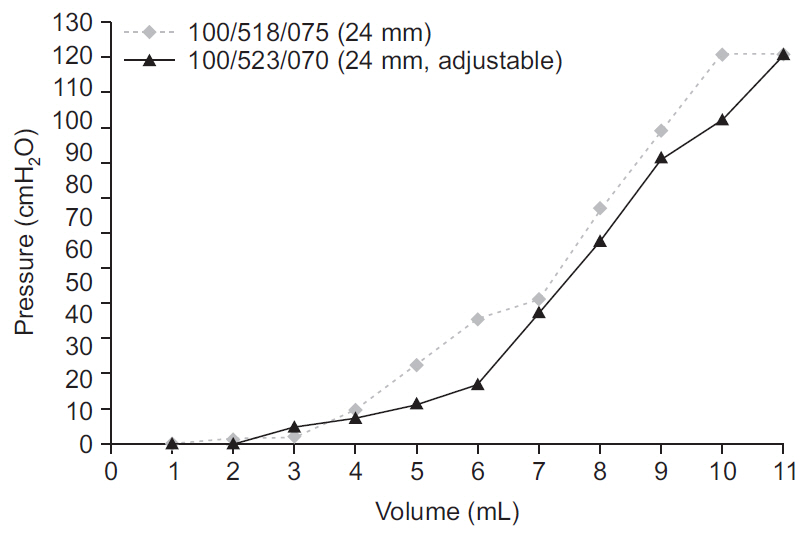Ann Rehabil Med.
2020 Oct;44(5):402-408. 10.5535/arm.19210.
What is the Adequate Cuff Volume for Tracheostomy Tube? A Pilot Cadaver Study
- Affiliations
-
- 1Department of Rehabilitation Medicine, Pusan National University School of Medicine–Biomedical Research Institute, Pusan National University Hospital, Busan, Korea
- KMID: 2508466
- DOI: http://doi.org/10.5535/arm.19210
Abstract
Objective
To determine the patterns of tracheostomy cuff pressure changes with various air inflation amounts in different types of tracheostomy tubes to obtain basic data for appropriately managing longterm tracheostomy.
Methods
We performed tracheostomy on a 46-year-old male cadaver. Three types of tracheostomy tubes (single-cuffed, double-cuffed, and adjustable flange), divided into 8 different subtypes based on internal tube diameters and cuff diameters, were inserted into the cadaver. Air was inflated into the cuff, and starting with 1 mL air, the cuff pressure was subsequently measured using a manometer.
Results
For the 7.5 mm/14 mm tracheostomy tube, cuff inflation with 3 mL of air yielded a cuff pressure within the recommended range of 20–30 cmH2O. The 7.5 mm/24 mm tracheostomy tube showed adequate cuff pressure at 5 mL of air inflation. Similar values were observed for the 8.0 mm/16 mm and 8.0 mm/27 mm tubes. Double-cuffed tracheostomy cuff pressures (7.5 mm/20 mm and 8.0 mm/20 mm tubes) at 3 mL air inflation had cuff pressures of 18–20 cmH2O at both the proximal and distal sites. For the adjustable flange tracheostomy tube, cuff pressure at 6 mL of cuff air inflation was within the recommended range. Maximal cuff pressure was achieved at inflation with almost 14 mL of air, unlike other tube types.
Conclusion
Various types of tracheostomy tubes showed different cuff pressures after inflation. These values might aid in developing guidelines For patients who undergo tracheostomy and are discharged home without cuff pressure manometers, this standard might be helpful to develop guidelines.
Keyword
Figure
Reference
-
1. Sengupta P, Sessler DI, Maglinger P, Wells S, Vogt A, Durrani J, et al. Endotracheal tube cuff pressure in three hospitals, and the volume required to produce an appropriate cuff pressure. BMC Anesthesiol. 2004; 4:8.
Article2. Braz JR, Navarro LH, Takata IH, Nascimento Junior P. Endotracheal tube cuff pressure: need for precise measurement. Sao Paulo Med J. 1999; 117:243–7.
Article3. Stauffer JL, Olson DE, Petty TL. Complications and consequences of endotracheal intubation and tracheotomy: a prospective study of 150 critically ill adult patients. Am J Med. 1981; 70:65–76.
Article4. Leigh JM, Maynard JP. Pressure on the tracheal mucosa from cuffed tubes. Br Med J. 1979; 1:1173–4.
Article5. Nordin U. The trachea and cuff-induced tracheal injury: an experimental study on causative factors and prevention. Acta Otolaryngol Suppl. 1977; 345:1–71.6. Klainer AS, Turndorf H, Wu WH, Maewal H, Allender P. Surface alterations due to endotracheal intubation. Am J Med. 1975; 58:674–83.
Article7. Shelly WM, Dawson RB, May IA. Cuffed tubes as a cause of tracheal stenosis. J Thorac Cardiovasc Surg. 1969; 57:623–7.
Article8. Bernhard WN, Yost L, Joynes D, Cothalis S, Turndorf H. Intracuff pressures in endotracheal and tracheostomy tubes. Related cuff physical characteristics. Chest. 1985; 87:720–5.9. Bernhard WN, Cottrell JE, Sivakumaran C, Patel K, Yost L, Turndorf H. Adjustment of intracuff pressure to prevent aspiration. Anesthesiology. 1979; 50:363–6.
Article10. Bryant LR, Trinkle JK, Dubilier L. Reappraisal of tracheal injury from cuffed tracheostomy tubes: experiments in dogs. JAMA. 1971; 215:625–8.11. Park YJ, Lee J, Kim SH, Ko SH, Shin MJ, Chang JH, et al. Care status of the ALS patients with long-term use of tracheostomy tube. Ann Rehabil Med. 2015; 39:964–70.
Article12. Suh MR, Choi WA, Choi YC, Lee JW, Hong JH, Park J, et al. Long-Term outcome of amyotrophic lateral sclerosis in Korean subjects. Ann Rehabil Med. 2017; 41:1055–64.
Article13. Fernandez R, Blanch L, Mancebo J, Bonsoms N, Artigas A. Endotracheal tube cuff pressure assessment: pitfalls of finger estimation and need for objective measurement. Crit Care Med. 1990; 18:1423–6.14. Dunn CR, Dunn DL, Moser KM. Determinants of tracheal injury by cuffed tracheostomy tubes. Chest. 1974; 65:128–35.
Article15. Lewis FR Jr, Schiobohm RM, Thomas AN. Prevention of complications from prolonged tracheal intubation. Am J Surg. 1978; 135:452–7.
Article16. Durbin CG Jr. Techniques for performing tracheostomy. Respir Care. 2005; 50:488–96.17. Hess DR. Tracheostomy tubes and related appliances. Respir Care. 2005; 50:497–510.18. Breatnach E, Abbott GC, Fraser RG. Dimensions of the normal human trachea. AJR Am J Roentgenol. 1984; 142:903–6.
Article19. St John RE, Malen JF. Contemporary issues in adult tracheostomy management. Crit Care Nurs Clin North Am. 2004; 16:413–30.20. Otoch JP, Minamoto H, Perini M, Carneiro FO, de Almeida Artifon EL. Is there a correlation between right bronchus length and diameter with age? J Thorac Dis. 2013; 5:306–9.21. Al-Shaikh B, Stacey SG. Essentials of equipment in anaesthesia, critical care, and peri-operative medicine. Edinburgh, UK: Elsevier;2018.22. Dullenkopf A, Gerber A, Weiss M. Fluid leakage past tracheal tube cuffs: evaluation of the new Microcuff endotracheal tube. Intensive Care Med. 2003; 29:1849–53.
Article
- Full Text Links
- Actions
-
Cited
- CITED
-
- Close
- Share
- Similar articles
-
- Airway Obstruction with Armored Tracheostomy Tube by Swelling of Inner Layer: A case report
- Care Status of the ALS Patients With Long-Term Use of Tracheostomy Tube
- Anesthetic experience of a patient with tracheomegaly: A case report
- Clinical Survey of Appropriate Cuff Volume and Pressure during General Anesthesia in Pediatric Patients
- Airway Obstruction due to Huge Dried Mucous Plug Discovered during Induction of Anesthesia : A case report



